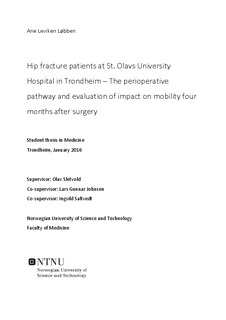| dc.description.abstract | Background: Hip fracture patients are characterized by old age and multiple comorbidites. Despite the relatively simple surgery needed for treatment, the patient group is a challenge for the anesthesist and the orthopaedic surgeon. We have described the perioperative pathway after a hip fracture at St. Olav University Hospital in Norway, and investigated how various perioperative factors affect mobility four months after surgery, namely time from fracture to surgery, intraoperative hypotension and blood transfusion therapy during the hospital stay. Methods: This observational study is based on data from the Trondheim Hip Fracture Trial. Home-dwelling hip fracture patients of 70 years or older and able to walk 10 meters prefracture, were included from April 2008 to December 2010. Data from pre-, peri- and postoperative monitoring was collected from hospital records. The primary outcome was mobility measued by Short Physical Performance Battery (SPPB). To conduct this study, a modification of the original approval (REK4.2008.335) to the Regional Committe of Ethics in Medical Research was made (2009/648_19/REKmidt). Results: In total, 1077 hip fracture patients were assessed for eligibility, and 397 were included in the trial. Two hundred and nine patients (52.6 %) received blood transfusions during the hospital stay, and 135 patients (34.0 %) experienced a hypotensive episode during surgery. A total of 343 patients (86.4 %) had surgery within 48 hours after admission, as compared to 47 patients (11.8 %) who had surgery more than 48 hours after admission.We found an association between blood transfusion therapy and reduction in SPPB score four months after surgery (p = 0.000), while time from fracture to surgery and presence of intraoperative hypotension did not affect the outcome. Discussion/conclusion: The decrease in SPPB score after four months in patients receiving blood transfusions during the hospital stay is most likely due to a combination of factors, such as the extent of anemia, fracture type and possibly the blood transfusions themselves. Intraoperative hypotension among hip fracture patients is common. Further research on the effect of the intraoperative hypotension is needed. | nb_NO |
